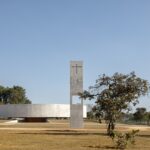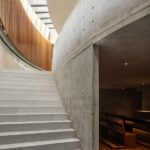Embracing Spirituality: Sagrada Familia Parish

Situated in Brasilia, Brazil, the Sagrada Familia Parish stands as a testament to the harmonious relationship between spirituality, nature, and community. Designed by ARQBR Arquitetura e Urbanismo, this architectural marvel embodies the essence of Catholicism while embracing the surrounding landscape with grace and reverence.
A Fusion of Spirituality and Nature
At the heart of the Sagrada Familia Parish lies a profound connection between spirituality and the natural world. Rooted in the Catholic tradition, the architectural concept reflects the sacred rituals and symbols that define the faith. The circular nave, a central feature of the design, symbolizes inclusivity and welcome, drawing the congregation closer to the altar in a gesture of unity and communion.

Illuminating Spaces
Natural light plays a pivotal role in shaping the interior ambiance of the parish. Through a circular opening in the roof, sunlight filters into the nave, casting ethereal rays that illuminate the sacred space below. This interplay between light and shadow creates a serene atmosphere conducive to contemplation and prayer, while also establishing a connection to the external landscape.
Integration with the Landscape
The architecture of the Sagrada Familia Parish seamlessly integrates with the surrounding landscape, blurring the boundaries between built environment and natural terrain. Elevated on six pillars, the circular concrete volume appears to float above the ground, allowing glimpses of the horizon to permeate the interior space. This symbiotic relationship between architecture and landscape evokes a sense of awe and wonder, inviting worshippers to experience the divine presence in the world around them.

Synthesis of Brasilia’s Essence
In essence, the architectural concept of the Sagrada Familia Parish encapsulates the spirit of Brasilia itself. The delicate placement of the architectural complex atop the terrain, coupled with its openness to the horizon, reflects Brasilia’s architectural legacy. Moreover, the seamless integration of public and private space underscores the importance of community and sacredness within the urban fabric. Recognized by UNESCO as a World Heritage Site, Brasilia’s landscape serves as a foundational element that enriches the architectural tapestry of the city.
The Sagrada Familia Parish stands as a testament to the enduring power of architecture to transcend the physical realm and evoke a sense of spiritual transcendence. In its embrace of spirituality, nature, and community, this architectural masterpiece continues to inspire awe and reverence among all who encounter its sacred spaces.





























